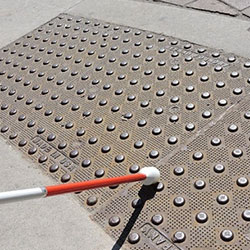









Tactile walking surface indicators (TWSI), also known as detectable warning surfaces, are textured ground surface indicators that provide important navigational cues for individuals who are blind or have low vision. In Canada, the installation of compliant TWSIs on pedestrian routes is mandated under various provincial and national accessibility regulations.
This blog provides a comprehensive overview of the key Canadian codes and standards that regulate the design and placement of TWSIs. We'll explore the most current federal, provincial, and municipal accessibility requirements across the country.
TWSIs are specialized textures installed on walking surfaces to convey essential information through touch and sound to pedestrians with vision impairments. Two main types exist:
TWSIs provide critical navigational and hazard cues to individuals with visual disabilities through:
When thoughtfully implemented, TWSIs enable independent and intuitive wayfinding and safety for pedestrians with vision loss.
In Canada, various regulations at the federal, provincial, territorial, and municipal levels mandate TWSI installation to create accessible public realms. Let's look at the major standards:
Canada has nationwide standards that provide baseline accessibility requirements. Key regulations include:
Provincial and Territorial Regulations
Most provinces and territories have their own accessibility laws that require TWSI installation. For example:
Many cities have additional by-laws and design standards for TWSIs. For instance:
So, in addition to nationwide standards, provincial, territorial, and civic regulations can impose localized TWSI requirements that contractors must adhere to.
Both warning and guidance TWSIs play vital roles in public realm accessibility and must be installed at key locations, including:
Warning TWSIs:
Guidance TWSIs:
TWSIs must adhere to strict technical requirements outlined in various Canadian codes and standards to ensure proper detectability and functionality. Key specifications include:
By meeting these specifications, TWSIs will reliably signal key cues through touch and sound when tapped by canes or stepped on by pedestrians. Compliant TWSIs optimize accessibility and safety.
A: TWSIs primarily aid those with low vision or legal blindness but also assist users with cognitive or physical disabilities.
A: Guidance TWSIs are mandated along interior/exterior circulation paths, transit platforms, open public spaces, recreational trails, etc.
A: Durable options like concrete, stone, metal, engineered plastics, porcelain, and rubber can be used if properly designed.
A: Through provincial accessibility acts that require TWSIs at new and renovated public facilities and infrastructure.
A: Through by-laws, facility accessibility design standards, and public realm master plans at civic infrastructure.
As Canada's population ages and diversifies, creating inclusive infrastructure that accommodates users of all abilities grows increasingly important. Implementing proper TWSIs under Canadian regulations is a key strategy for crafting accessible, barrier-free public realms.
With its rich experience supplying compliant TWSI solutions across Canada, Tactile Solution Canada is the ideal partner for accessibility projects of all sizes. Their extensive product range includes systems from leading manufacturers like Armor Tile®, Access Tile® Systems, Advantage® Tactile Systems, Ecoglo® and Elan® Tiles.
With solutions customizable to any application, Tactile Solution Canada can recommend the optimal TWSIs to fulfil your specific accessibility goals while meeting all pertinent Canadian codes and standards. Contact their experts today to make your next public project genuinely accessible to all citizens.
